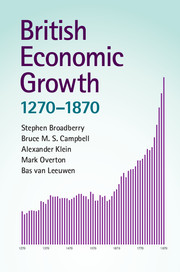Book contents
- Frontmatter
- Contents
- List of Tables
- List of Figures
- List of Appendices
- Preface and acknowledgements
- List of Weights, measures and money
- Prologue: Historical national income accounting
- Part I Measuring economic growth
- 1 Population
- 2 Agricultural land use
- 3 Agricultural production
- 4 Industrial and service-sector production
- 5 GDP and GDP per head
- Part II Analysing economic growth
- Bibliography
- Index
1 - Population
Published online by Cambridge University Press: 05 January 2015
- Frontmatter
- Contents
- List of Tables
- List of Figures
- List of Appendices
- Preface and acknowledgements
- List of Weights, measures and money
- Prologue: Historical national income accounting
- Part I Measuring economic growth
- 1 Population
- 2 Agricultural land use
- 3 Agricultural production
- 4 Industrial and service-sector production
- 5 GDP and GDP per head
- Part II Analysing economic growth
- Bibliography
- Index
Summary
Introduction
Economic growth can be either extensive or intensive. Extensive growth arises where more output is produced in line with a growing population but living standards remain constant, while intensive growth arises where more output is produced by each person. In the former case, there is no economic development, as the economy simply reproduces itself on a larger scale: in the latter, living standards rise as the economy goes through a process of economic development. To understand the long-run growth of the British economy reaching back to the thirteenth century therefore requires knowledge of the trajectories followed by both population and GDP. Of particular interest is whether periods of intensive growth, distinguished by rising GDP per head, were accompanied by expanding or contracting population. For it is one thing for living standards to rise during a period of population decline, such as that induced by the recurrent plagues of the second half of the fourteenth century, when survivors found themselves able to add the land and capital of those who had perished to their own stocks, but quite another for living standards and population to rise together, particularly given the emphasis of Malthus [1798] on diminishing returns. Indeed, Kuznets (1966: 34–85) identified simultaneous growth of population and income per head (i.e. the concurrence of intensive and extensive growth) as one of the key features that distinguished modern from pre-industrial economic growth.
- Type
- Chapter
- Information
- British Economic Growth, 1270–1870 , pp. 3 - 45Publisher: Cambridge University PressPrint publication year: 2015



